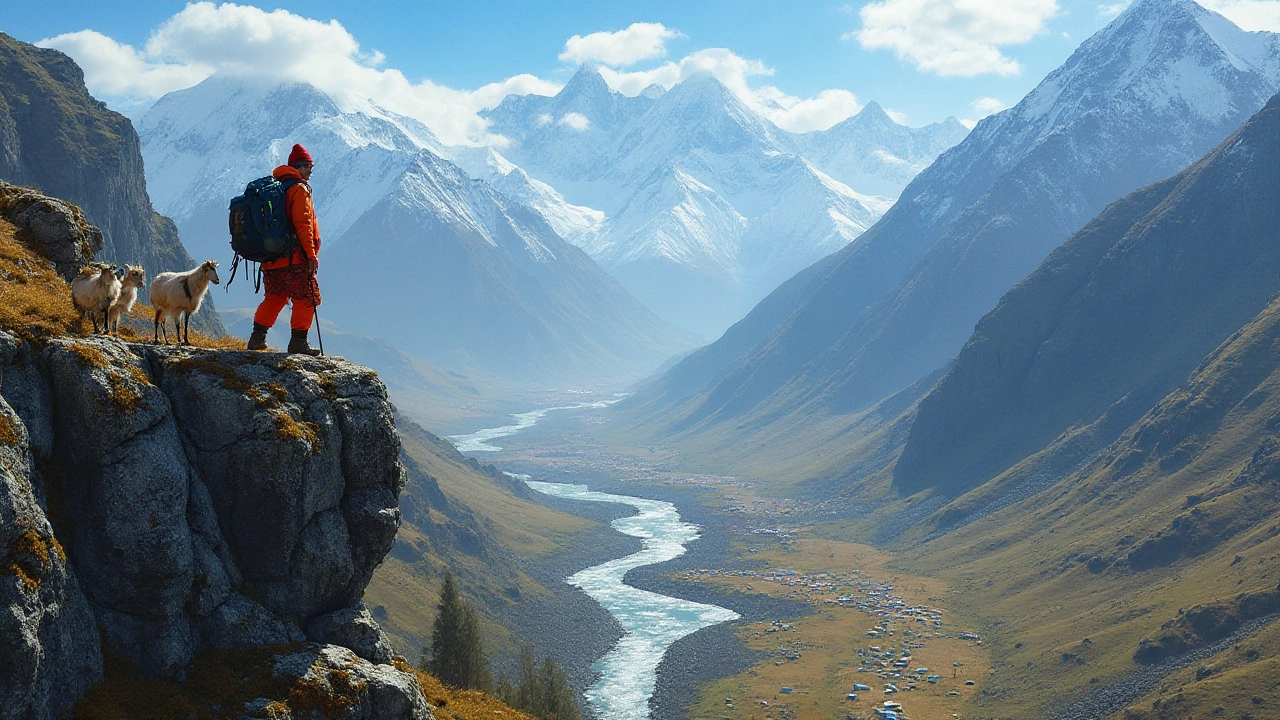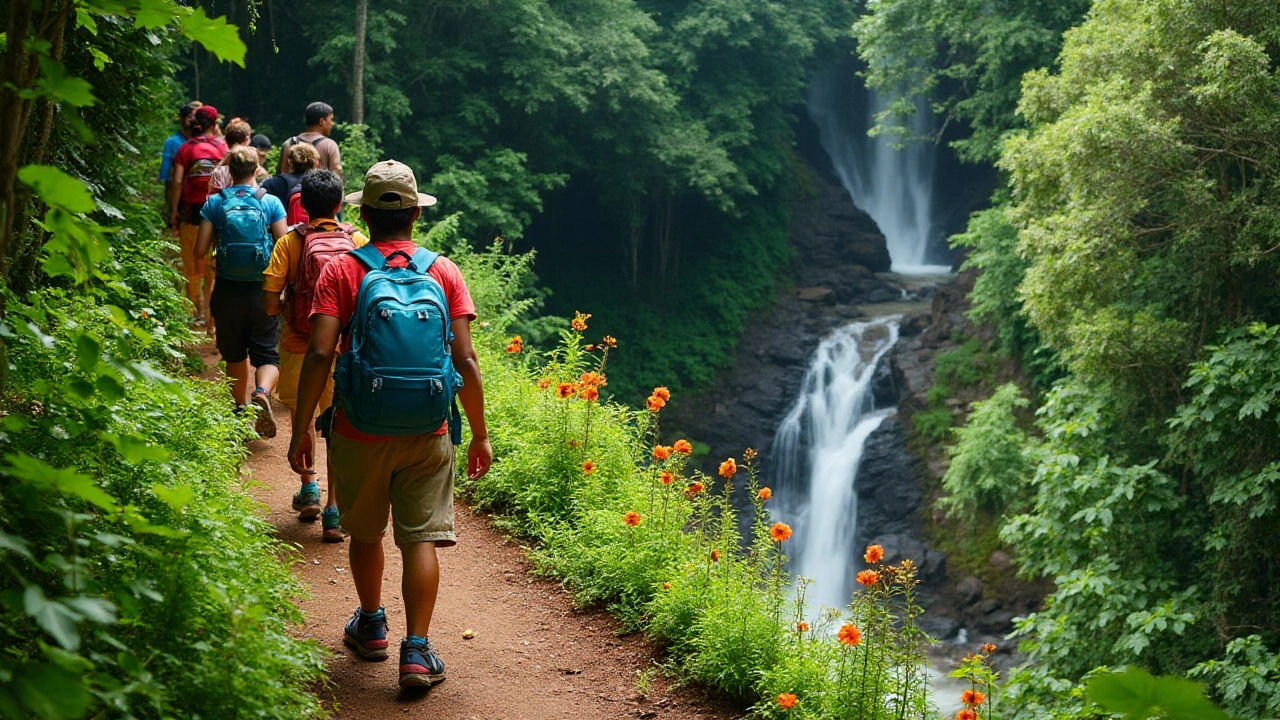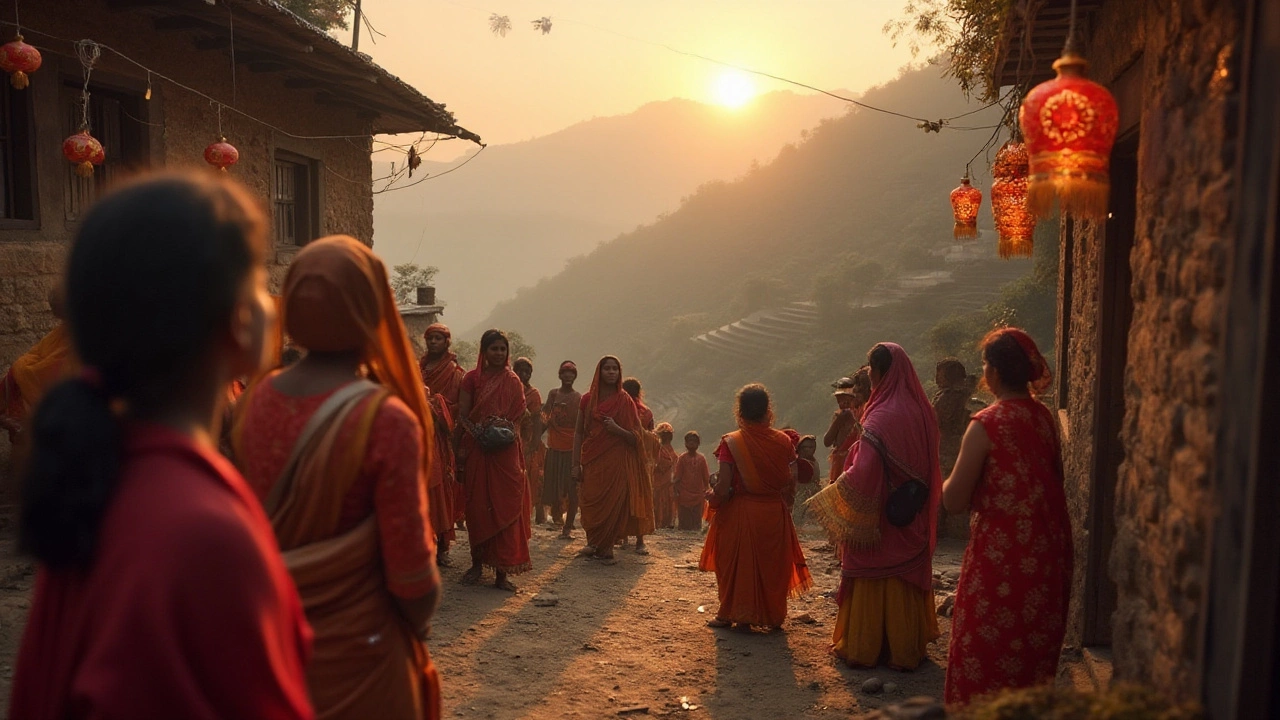Top Hiking Destinations in India for Adventure Seekers
 Dec, 30 2024
Dec, 30 2024
India, with its diverse landscapes and cultural allure, has become a paradise for hikers. Each trail is a gateway to discovering the country's natural beauty and the deep-rooted traditions of its people. Whether you find yourself gravitating towards the towering Himalayas or the serene Western Ghats, there's a trail that invites you to a unique adventure.
What makes hiking in India remarkable is not just the physical challenge, but the opportunity to weave through paths that echo ancient stories and traditions. As you meander through these trails, you often encounter welcoming villages, majestic views, and a rich tapestry of flora and fauna.
With careful preparation and an open spirit, hiking in India provides an experience that's both spiritually uplifting and deeply rewarding. So, lace up your boots, pack your bags, and get ready to explore the best trekking destinations this incredible country has to offer.
- Himalayan Trekkings
- Western Ghats Delights
- Lesser-Known Trails
- Cultural Experiences on Trails
- Hiking Tips and Precautions
Himalayan Trekkings
When it comes to hiking in India, the majestic Himalayas always steal the spotlight. These towering peaks, revered and mystical, draw adventurers and seekers alike to witness their unrivaled beauty. From snow-capped mountains to verdant valleys, the Himalayas provide trails that cater to both seasoned trekkers and curious beginners. One of the most famous hikes here is the Chadar Trek, a unique experience where you walk on the frozen Zanskar River, surrounded by icy cliffs under a canopy of stars. Then there’s the famous Valley of Flowers trek, bursting with colorful blooms against the backdrop of imposing peaks, inviting countless nature enthusiasts to witness this spectacle of nature every year.
The Roopkund Trek is yet another spellbinding journey, leading adventurers to the mysterious skeleton lake, surrounded by myths that echo through time. The story is that the remains found around the lake are believed to belong to an ancient pilgrimage that met an untimely demise. Such stories add a fascinating layer of intrigue to your journey. A pleasant surprise for many is the Melanjura Cafe, a quaint establishment along the Markha Valley Trail that offers weary travelers warm tea and local tales that warm the spirit as much as the drink warms the bones. "The Himalayas are not just a mountain range but a spiritual teacher," the legendary mountaineer Edmund Hillary once remarked, capturing perfectly the sense of awe that this mountain range instills.
For each trek, it's crucial to prepare adequately, ensuring you have the right gear and acclimatize properly to the high altitudes. This region demands respect and preparation, but those who venture into its vast domains come back with stories and memories that last a lifetime. Visits to these trails also provide a way to engage with local communities, many of whom share fascinating insights into their traditional ways. By trekking in these areas, you're not only exploring the breathtaking nature but also contributing to local economies, fostering a cultural exchange that enriches both visitor and host.
Let’s not forget the power of technology and safety. Always check the weather forecasts and local advisories before embarking on your journey. Digital maps and local guides can be invaluable, ensuring you stay safe and on track. The Himalayan trails, while inviting exploration, must also be met with a commitment to safety and an understanding of the environment's unpredictable nature. Engage with seasoned guides who respect the local cultures and natural dynamics, ensuring your trek enhances your perspective while preserving the spiritual and environmental sanctity of these mountains.
Planning a hike in this wondrous region requires attention to detail and a spirit of adventure that embraces each challenge as part of the journey. Whether you’re scaling peaks or wandering through serene valleys, the Himalayas offer an experience that is as rewarding as it is challenging, beckoning trekkers with its majestic beauty and mystical allure. So, ready your backpack, embark on an unforgettable journey, and allow the Himalayas to etch their stories into your soul.
Western Ghats Delights
The Western Ghats, a UNESCO World Heritage site, is a lush paradise brimming with biodiversity and intrigue. Stretching over 1,600 kilometers along the western coast of India, this mountain range is a haven for nature lovers and hiking enthusiasts alike. The Ghats are renowned for their lush greenery, cascading waterfalls, and rich wildlife, offering a spectrum of trails that range from easy strolls to challenging treks.
One of the most popular trekking destinations in the Western Ghats is the Chembra Peak in Kerala. Standing at 2,100 meters, it is one of the highest peaks in the region and provides breathtaking views of the surrounding valleys and the heart-shaped lake, which is a major attraction point. The trek to Chembra Peak is moderately challenging, attracting both seasoned trekkers and adventurous newcomers. Rains bring an additional layer of magic to the landscape, enriching the already vibrant greens and filling the air with a mossy, earthy aroma. Yet, caution is advised as the trails can become treacherous during monsoon season.
Maharashtra's Rajmachi Fort is another significant trek in the Western Ghats. It is a vantage point that offers panoramic vistas of the Sahyadri mountains. The trek, which is graded as easy, is ideal for beginners and is filled with historical intrigue. Constructed by the Satavahanas, the fort underwent significant expansion under Shivaji Maharaj, making it a site of historical significance. The journey winds through dense forests and verdant fields and is home to numerous small waterfalls, particularly invigorating during the rainy season.
"The Western Ghats are an excellent example of the intertwining of lush biodiversity and historic evolution, providing not just a physical challenge but a narrative of India's natural heritage," says Dr. Ramesh Letur, an ecologist who has spent decades studying the region.
The Agumbe Rainforest, dubbed as the Cherrapunji of South India, is another must-visit trekking destination. Known for its high rainfall, the area offers enchanting trails that cut through thick forest canopies and diverse ecosystems. The trail can be particularly appealing during rainy weather, showing off the abundant waterfalls, including the famous Barkana Falls and Jogigundi. Trekking through Agumbe not only tests one's endurance but also serves as an environmental lesson on the critical need for conservation of such unique habitats.
Unique Flora and Fauna
The Western Ghats are home to over 7,000 species of flowering plants, 139 mammal species, 508 bird species, 179 amphibian species, 6,000 insect species, and 290 freshwater fish, making it a biodiversity hotspot. Among these are several species endemic to the region, meaning they are found nowhere else on the planet. The wide variety of flora and fauna makes hiking in this region not only a feast for the eyes but an educational adventure. Bird watchers flock to the region, hoping to catch sight of species like the Malabar Pied Hornbill and Nilgiri Wood Pigeon.
Also intriguing is the Ghats' role as a climate buffer. With their dense vegetation, they effectively intercept the rain-laden monsoon winds, bringing life-sustaining rain to the otherwise dry regions of the Deccan Plateau. The mountain range's role in the region's climate system is a testament to its ecological importance, adding another layer of interest for the scientifically curious trekkers who wander these ancient paths.
Whether seeking physical challenge, scenic beauty, or a deep dive into ecological richness, the Western Ghats promise a captivating trek in one of the world's most vital environments. This range invites hikers to discover its secrets and inspires an appreciation for conservation efforts to preserve these critically important landscapes.

Lesser-Known Trails
While the renowned Himalayan trails attract trekkers worldwide, India is peppered with a wealth of lesser-trekked paths that offer solitude and unspoiled beauty. These trails, often somewhat obscured from the bustling tourist circuits, offer unique terrains and landscapes that transform hiking from a simple pastime into a memorable journey. One such place is the Dzukou Valley, known for its enchanting hills and lush green landscapes nestled in the North-Eastern state of Nagaland. Known as 'The Valley of Flowers of the East,' it captivates travelers with its undulating mounds carpeted with a myriad of seasonal blooms, especially the Dzukou Lily, unique to this region.
The experience of trekking through these lesser-known gems is akin to discovering hidden pockets of serenity and beauty where nature remains blissfully untouched. The meandering trails of Spiti Valley in Himachal Pradesh, for instance, provide a window into the world of stark landscapes, monasteries perched on cliffs, and ancient Tibetan culture. Trekkers often find themselves sharing paths with local shepherds and their herds, adding to the trail’s authenticity and charm. Historians have noted these nomadic lifestyles as key to understanding human adaptation in harsh climates and terrains.
Down south, the lesser-celebrated trails of the Western Ghats, such as the Agumbe Rainforest in Karnataka, offer a distinctly different experience. Known as the 'Cherrapunji of the South,' Agumbe receives intense rainfall, fostering dense vegetation and an intriguing array of fauna. Walking through these rain-laden paths amidst diverse wildlife, including the iconic King Cobra, can be both thrilling and educational. According to a study published in the Journal of Threatened Taxa, Agumbe hosts approximately 80% of India’s amphibian species.
For those seeking both inner peace and untouched wilderness, the Roopkund trek in Uttarakhand is another hidden treasure. This trek comprises an eerie yet fascinating experience, as it leads to the Skeleton Lake, known for the human skeletons that can be seen at its bottom during icy conditions. Anthropological research, including studies by the International Journal of Anthropology, suggests these remains date back to the 9th Century, providing glimpses into the mysteries of ancient pilgrim routes.
As famed explorer Sir Ranulph Fiennes once remarked, "The latter part of a trek, when exhaustion collides with the ultimate goal, is where truly extraordinary feats are achieved." This sentiment rings especially true for India's less-trekked terrains, where nature unfurls her secrets to those willing to wander off the beaten track.
Tips for Exploring These Trails
Embarking on such lesser-known paths requires more than just an adventurous spirit. Preparedness and respect for the environment are crucial. Always research and understand the local customs and regulations of the area you're visiting. Travel light but wise, ensuring your gear supports both comfort and the ruggedness of these offbeat paths. Hiring local guides can enrich your experience and help navigate the delicate balance of interacting with pristine nature and local communities respectfully.
It's also vital to leave no trace by disposing of waste responsibly, respecting local cultures, and subscribing to sustainable travel practices. In these settings, human impact can be rendered less unforgiving, contributing to the locale's preservation for future trekkers. These long-forgotten or yet-to-be-discovered passages bear stories, tales untold but to those that dare to wander without assumptions, seeking simply the embrace of Earth's unbridled beauty.
Cultural Experiences on Trails
Embarking on a hiking adventure in India is not just about conquering the physical challenges of the terrain; it’s an invitation to delve into the vibrant tapestry of diverse cultures that flourish along the trails. Many trekking routes pass through remote villages where the rhythm of life has remained unchanged for centuries. These villages, nestled amidst towering mountains or lush valleys, offer hikers a glimpse into the age-old traditions and customs that are integral to India's identity. Here, the locals extend a warm welcome, often inviting visitors into their homes and sharing stories passed down through generations. It's not uncommon to be offered a warm cup of chai, a simple gesture that embodies the legendary Indian hospitality.
One of the most enriching aspects of these cultural encounters is witnessing the traditional festivals and rituals that take place throughout the year. The Himalayan villages, for instance, are famous for their colorful festivals that are a treat for the senses. Celebrations such as Losar and Hemis Festival are marked by vibrant dances, elaborate costumes, and melodious music, offering trekkers a chance to partake in the joyous spirit of the community. The vibrant attire and intricate masks worn during these festivals tell stories of gods, legends, and the enduring relationship between man and nature.
"Traveling in India offers a continuous pageant of humanity and aeons of traditions. It makes you feel part of something much bigger," says author Mark Tully, capturing the essence of cultural richness found off the beaten path.
Adding another layer to such experiences is the opportunity to sample traditional cuisine that reflects the geographical and cultural diversity of the region. Each village or area boasts its own unique delicacies, crafted using local ingredients and age-old cooking techniques. In the foothills of the Western Ghats, for example, hikers can savor home-cooked meals rich with spices, coconut, and tamarind, forming a delightful culinary journey that complements the scenic beauty. Sitting among the villagers, sharing a meal, and exchanging stories often become cherished memories that stay with hikers long after the trek has ended.
The villagers, many of whom lead a subsistence lifestyle, are guardians of centuries-old crafts and skills. Trekkers can often witness artisans at work, from knitting intricate wool patterns in the cold Himalayas to weaving colorful fabrics in the vibrant states of the northeast. These artistic practices not only add color to the hike but also offer insights into the history and identity of the region. For those interested in supporting local communities, purchasing these handcrafted goods provides a meaningful way to contribute to the well-being of these resilient people.
In essence, hiking in India is as much a cultural journey as it is a physical one. Whether it’s through the warm hospitality of the locals, the mesmerizing festivities, or the simple act of sharing a traditional meal, each experience adds a unique chapter to a trekker’s story, making the trails not just paths through nature, but bridges that connect different worlds. The next time you lace up for a trek in this vast country, prepare to carry not just your hiking gear but an open heart ready to embrace the cultural richness and warmth of India’s trails.

Hiking Tips and Precautions
Embarking on a hiking adventure in the diverse terrain of India can be exhilarating, but it's essential to prepare thoroughly to ensure a safe and memorable journey. The foremost consideration should be your physical fitness. Most of the popular trekking regions are set at significant altitudes, which can be challenging. Engaging in regular cardiovascular exercises like running or cycling, combined with strength training, helps build the endurance needed for these trails.
Proper gear is a must. Investing in a good pair of hiking boots with sturdy grips can be the difference between a smooth stroll and a slippery mishap. Your attire should be comfortable and adaptable to sudden weather changes. Layering is key in many Indian trails, especially in the Himalayas, where temperatures can drop swiftly as the sun sets. Don’t forget to pack a lightweight, waterproof jacket.
Navigating through unfamiliar trails necessitates a reliable map or a GPS device. While many treks, especially those in the Western Ghats, are marked, it’s easy to go off-course. A wrong detour could lead you deep into dense forests. Carrying a physical map provides a tangible guideline when technology fails.
Another critical aspect is hydration. The effort put into trekking can quickly deplete your body of fluids. It’s recommended to carry at least two liters of water, and consider adding electrolytes to your supply, especially when trekking in hotter climates like the Southern trails. Water purification tablets are also a prudent choice, should you need to refill from natural sources along the way.
Respecting the local culture and environment is fundamental. The trails cross through many villages where the communities hold strong ties to their customs. Being mindful and courteous towards them can enhance your journey. Keeping the trails clean by packing out all trash, respecting wildlife by maintaining a safe distance, and sticking to the marked paths ensure that these beautiful areas remain pristine for future adventurers.
“The wilderness holds answers to questions we have not yet learned to ask.” – Nancy Newhall
Safety should never be compromised. Always inform someone about your trek details, including the route and the expected return time. Many trekking areas in India do not have reliable mobile connectivity, making it crucial to have a detailed plan shared with friends or family. Carrying a fully charged power bank ensures your devices remain powered in emergencies.
If you’re an inexperienced hiker, it’s wise to join guided treks where seasoned guides can provide insight into the terrain and conditions. They'll also share tips on how to handle unexpected situations, such as weather changes or altitude sickness, which can manifest in higher regions. Being knowledgeable about altitude sickness symptoms—like headaches, nausea, or dizziness—allows for prompt action. Descending to a lower altitude immediately helps alleviate these symptoms.